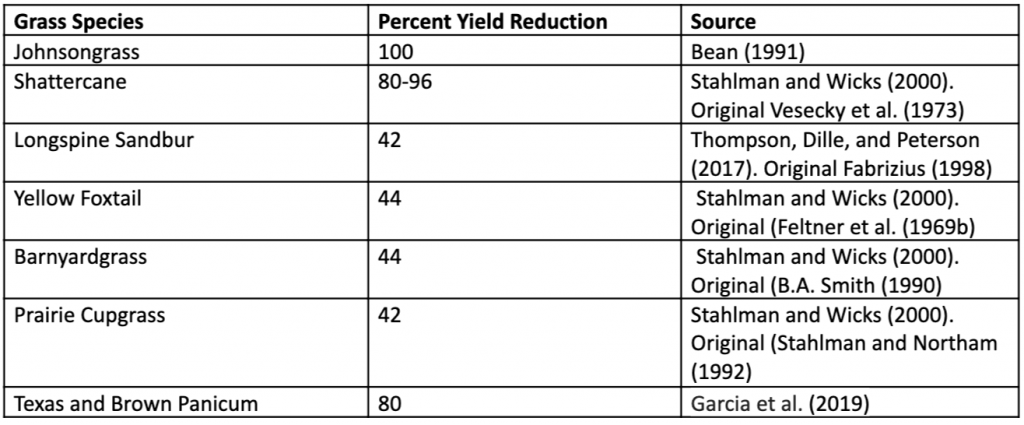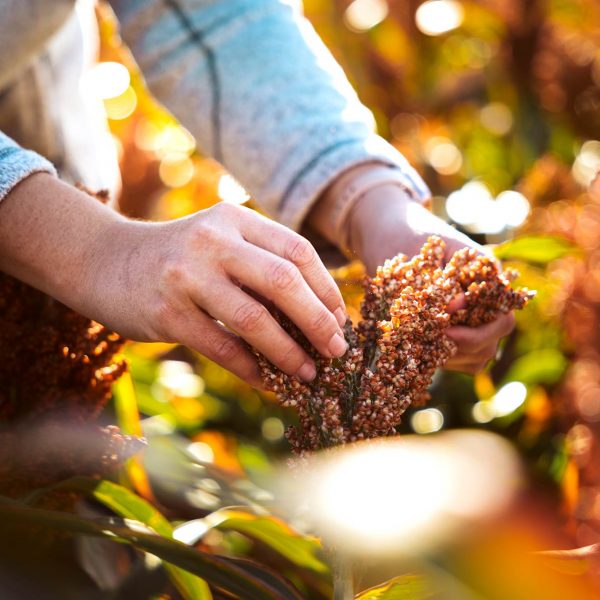Grassy Weed Competition in Sorghum
By Brent Bean, Ph.D., Sorghum Checkoff Director of Agronomy
In sorghum, there is a strong need for more herbicide options. This is especially true for postemergence grass control and was listed as a major objective in the United Sorghum Checkoff 2015 Strategic Plan for crop improvement (USCP, 2015). The information below demonstrates why over-the-top grass control technology is critical to the success of sorghum yields and a tool that will dramatically enhance producers ability to manage grassy weeds in sorghum.
Weeds are a major threat to crop production in the United States and around the world. In sorghum, weed control trials from 2007 to 2016 showed the average yield loss of uncontrolled weeds was 47% with a potential economic cost of over $950 million annually (Dille et al., 2020). Dense populations of some weed species and moderate densities of others, when coupled with dry weather, can prevent sorghum from producing any grain (Stahlman and Wicks, 2000).
The amount of yield reduction from weeds will be dependent on a number of factors, including the following (Stahlman and Wicks, 2000):
- Weed species
- Density of weeds
- Time of weed emergence
- Duration of interference
- Environmental conditions – factors that could influence competitiveness of the weed(s) such as soil pH, fertility level, rainfall, daily temperature, humidity, etc.
- Crop row spacing and plant population
There are fewer grain sorghum acres planted in the U.S. than corn or soybeans. As a result, fewer herbicides have been developed for sorghum by crop protection companies. Grain sorghum has not benefited from traits derived from genetically modified (GMO) hybrids, further limiting the herbicide options available to the crop. Herbicide options for both pre and postemergence weed control in sorghum are limited, and controlling grassy weeds postemergence is especially challenging.
Two of the most troublesome grass weeds in sorghum are its close relatives: Johnsongrass (Sorghum halepense) and shattercane (Sorghum bicolor ssp. Drummondii) (Defelice, 2006). Herbicides currently available will not control these two weeds in sorghum (Thompson et al., 2017). A 2015 survey conducted by the Weed Science Society of America the following grass weeds, listed by state, as the most troublesome in sorghum (WSSA):
| Barnyardgrass | OK |
| Bermudagrass | GA |
| Broadleaf signalgrass | NC, TX |
| Crabgrass spp. | OK, DE, KS, KS, MO |
| Fall panicum | DE |
| Foxtail spp. | KS, NC, OK, DE |
| Johnsongrass | GA, IL, KS, MO, OK, TX |
| Sandbur | KS, OK |
| ShattercaneIL | KS, MO, TX |
| Texas Millet (Panicum) | GA, IL, NC, OK, TX |
No-till and minimum till systems have become increasingly popular throughout sorghum growing regions in the U.S. These systems greatly improve soil moisture retention and minimize both water and soil erosion. Perennial warm season grasses can be particularly difficult to control in these systems (Thompson et al., 2017). Problem grasses include bermudagrass, tumble windmillgrass, tumblegrass and sand dropseed. Tillage is the only viable option for control of these weeds in many cases (Thompson et al., 2017).
Few weed competition studies have been conducted in sorghum, and this is especially true with grassy weeds. When left untreated, grass competition reduced grain sorghum yields from 42-100%, as documented in the table below:

Grass control is limited almost exclusively to the chloroacetamide (Group 15) class of preemergence herbicides. These herbicides can be effective on some annual grass species, but soil residual is relatively short, leading to poor control later in the growing season. In addition, activity is dependent on timeliness of the application and rainfall or irrigation to incorporate and activate the herbicide. Too much rainfall can leach the herbicide out of the seed zone, or grass can emerge prior to herbicide activation, resulting in poor weed control. Because of the inconsistency that can be associated with chloroacetamide herbicides, there is a strong need for effective postemergence grass herbicides and is often cited by growers as their number one need in grain sorghum production(USCP, 2015).
References
Bean, B.W. 1991. Johnsongrass control in sorghum. Summaries of 1991 TAEX and TAES Agronomic Demonstrations and Studies Districts 1 and 2: Texas A&M Research and Extension Center – Amarillo.
Defelice, M.S. 2006. Shattercane, Sorghum Bicolor (L.) Moench Ssp. Drummondii (Nees ex Steud.) De Wet ex Davidese – Black sheep of the family. Weed Technol. 20:1076–1083. doi:10.1614/WT-06-051.1
Dille, J., Stahlman, P., Thompson, C., Bean, B., Soltani, N., & Sikkema, P. (n.d.). 2020. Potential yield loss in grain sorghum (Sorghum bicolor) with weed interference in the United States. Weed Technology, 1-6. doi:10.1017/wet.2020.12
Garcia, J., J. McGinty, J. Foster, G. Schuster, and A. Umphres. 2019. Weed Management in Imidazolinone Tolerant Grain Sorghum in South Texas. Poster.Texas Plant Protection Conference. Bryan, TX.
Stahlman, P.W. and G.A Wicks. 2000. Weeds and their control in grain sorghum. P. 535-589. In C.W. Smith and R.A. Frederiksen (ed). Sorghum: Origin, History, Technology, and Production. John Wiley & Sons, Inc.
Thompson, C.R., J.A, Dille, and D.E. Peterson. 2017. Weed competition and management in sorghum. In Sorghum:State of the Art and Future Perspectives. doi:10.2134/agronmonogr58.2014.0071
United Sorghum Checkoff Program Strategic Plan. 2015. https://www.sorghumcheckoff.com/wp-content/uploads/2020/04/4_24_15_strategic_plan.pdf.
WSSA. Baseline 2015 survey for 26 different crop, non-crop, aquatic, and natural areas. http://wssa.net/wssa/weed/surveys/




